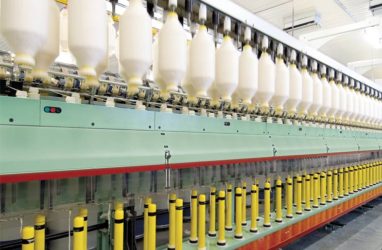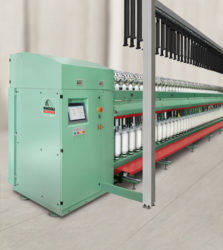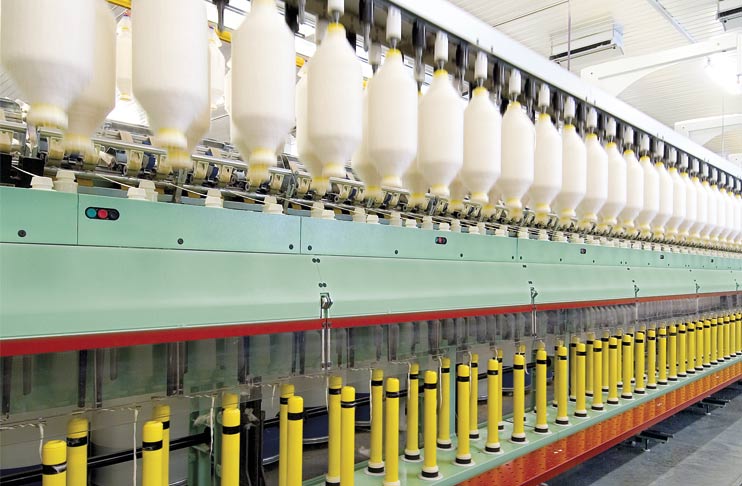
Few machines in a modern spinning mill are as critical as the roving frame. Building a solid and reliable roving frame is not an easy task and yet again it is absolutely necessary for the spinner as this machine can feed, depending on the count being produced, thousands of spindles at the spinning frames. Marzoli, the only European manufacturer of the full line of machines for spinning of short staple fibers with over 150 roving frames being sold every year worldwide, is the ideal referent for whoever wants to choose the best technology. Its new FT60 and FT70 represent a state-of-the-art solution, yielding the best results for efficiency, reliability and quality. The article aims at presenting from a technical and technological point of view these machines.
Drive system
The FT60 and FT70 are driven by independent drives for the drafting system, the flyers, the spindles and the bobbin rail. Every drive is coordinated by the central CPU which ensures perfect synchronization of all the movements involved in bobbin formation.
Spindle and flyer drives are group drives here motion is transmitted through toothed belts. In traditional machines spindles and flyers are moved by one motor which, through a long shaft, transmits motion to bevel gears which drive pulleys that drive belts which ultimately make flyers and spindles rotate. Group drives allow to substantially simplify this transmission systems. Each drive comprises several motors, each one driving a limited number of spindles/flyers. Each motor, through a pulley, drives toothed belts which transmit motion directly to the spindles/flyers. Shafts, gear boxes and bevel gears are eliminated.
With Marzoli group drives it is possible to;
- reduce maintenance costs: fewer transmission components are needed and lubrication is no longer required;
- reduce noise;
- reduce vibrations: lower mechanical transmission entails lower wear of transmission components and therefore lower vibrations. This enables the machine to work at higher speeds;
- increase transmission efficiency: transmission system comprises only a pulley and toothed belts: no shafts, no bevel gears are included. This allows to reduce energy consumption.
Drafting system
Marzoli roving frames can be equipped with a 3-over-3 or 4-over-4 top-of-the-class drafting system. There are two options for the cylinder diameters: the standard solution has a diameter of 32mm; however, in case there is a high percentage of short fibers in the processed material, cylinders with a diameter of 27mm can be used to reduce the gauge between nipping points. This guarantees a better control of short fibers during draft.
Marzoli drafting system can also rely on highly efficient cleaners for both top rollers and bottom drafting cylinders. For top rollers there are two options: rollers with rubber fins and revolving felt belts. For the bottom cylinders there are rubber scrapers. These solutions guarantee that at every turn both top rollers and bottom cylinders are always cleaned. This, along with the high quality of each and every component, entails the perfect control of fibers during draft and top quality of the roving.
The drafting drive comprises one motor, which drives the first cylinder, and an independent brushless motor, which drives second and third cylinders. Because of this unique configuration main draft can be set from touch screen or remotely via YarNet: no gear change is required. Furthermore the client can set exactly the desired draft ratio, he does not have to choose between different draft values, determined by the available gears.

False twist area
As bobbins on modern roving frames are arranged in two rows, rovings can have different angles at the delivery of the drafting system and at the entrance of the flyers’ top. It has been argued that these different angles can entail differences in the spinning triangle at draft delivery and different tensions of the rovings thereby causing an uneven take up of twist and variations in roving count.
On Marzoli machines all rovings lay parallel to one another: they have the same angle at the delivery of the drafting system and at the flyers’ entrance for both the front row and the back row of bobbins.
Individual sensors ensure that each and every roving break is properly detected and the machine securely stopped, even in case of roving overlap around the cylinder/top roller. On the other hand, if dust passed in front of the sensors the machine would not stop, it would continue to run. Individual sensors also make suction not required. This, along with the IE3 motors and an overall design meant to minimize energy consumption, allows to save up to 4 Kwh.
Roving tension is kept constant within a pre-set range through sensors that constantly monitor roving’s fluctuations between the delivery of the drafting system and the flyer’s top and adjust the speed of the spindles accordingly. These sensors play an important role in ensuring that there are no false drafts in the roving and that roving breaks are kept to a minimum.
Winding area
It is argued that to increase productivity and lower investment costs, spindlage and dimension of bobbins should be increased. This is only partially true: a higher number of spindles per machine reduces the cost of the investment as the total required number of spindles can be reached with fewer machines. From a unit cost (cost per spindle) point of view, there is an economic advantage that stems from the amortization of the cost of the head and rear stocks on a higher number of spindles per machine. However, the higher the number of spindles, the smaller the benefit stemming from a further increase in machine’s length. Machines exceeding a certain number of spindles also entail higher costs for electronics and drafting drive. Last but not least a higher number of spindles per machine causes a reduction in efficiency.
The FT60 (110mm gauge) can reach 224 spindles and produce bobbins of 16” x 6”. The FT70 (130mm gauge) has a spindlage up to 168 spindles and can produce packages of 16” x 7”. These numbers represent the limit in terms of number of spindles and dimensions of bobbins to maintain top efficiency standards. A higher number of spindles per machine would not give an additional benefit to the spinner as the decrease in machine efficiency would not be counterbalanced by the reduction in the average cost per spindle.
The flyers installed on Marzoli’s roving frames are made of ultra-light alloy and are dynamically balanced; so that even when working at high speeds, vibrations are kept to a minimum. Marzoli’s roving frames can reach up to 1,500 rpm mechanically; and the roving can be wound on standard tubes; with a diameter of 53.5 mm, or on thinner tubes; with a diameter of 48mm, to have a further slight increase in bobbin capacity.
The creel
The creel is equipped with hexagonal aluminum rollers to prevent false drafts; a very important aspect especially when working with combed slivers. Optic sensors positioned between the rollers ensure that in case of sliver break the machine is immediately stopped. Marzoli roving frames can be fed with cans with a diameter of up to 24”; which allow to reduce machine stops and increase its efficiency.
Doffing
One of the most crucial aspects on modern roving frames is automation especially on doffing since doff is costly, frequent, has a quite-important negative influence on efficiency (especially on long roving frames) and, if done manually, can damage the roving bobbins.
Nowadays several options for automatic doffing are available. One of the simplest, most reliable and fastest; automatic doffing systems is the one that Marzoli has implemented; tested and refined in the last twenty years. With this solution in less than 3 minutes full bobbins are replaced with empty tubes and the machine is restarted. During the new doffing cycle; the full bobbins are forwarded to the transport system; which carries the packages to the spinning frames.
Also a semi automatic doffing option of the machine is available. With this version ergonomics has been substantially improved if compared to standard manual-doffing machines. After bobbin formation is completed, the bobbin rail lowers and tilts out for an easy bobbin collection. Furthermore, there is a parking rail in front of the bobbin rail with empty tubes; so that substitution of full bobbins with empty tubes is as easy as possible.
Energy efficiency
To succeed in the highly competitive and globalized sector; spinners must minimize production costs of whom energy consumption represents an important component.
Marzoli roving frames represent an outstanding machine from the energy consumption point of view. This machine is the only one available on the market that does not need suction. In fact thanks to the individual sensors installed as standard any roving break can be promptly identified. No suction is required to capture the broken roving and make it pass in front of the photocell.
This, along with the IE3 premium efficiency motors; the light weight components (e.g. the bobbin rail in aluminum); and an overall design meant to minimize friction and transmission inefficiencies; entails an energy saving of over 4 Kwh for every hour of operation.


